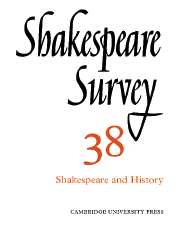Book contents
- Frontmatter
- Shakespeare’s History Plays: 1952–1983
- Shakespeare and History: Divergencies and Agreements
- Shakespeare’s Georgic Histories
- The Nature of Topicality in Love’s Labour’s Lost
- The Tragic Substructure of the Henry IV Plays
- Hal and the Regent
- The Rite of Violence in I Henry IV
- The Fortunes of Oldcastle
- Hand D in Sir Thomas More: An Essay in Misinterpretation
- Livy, Machiavelli, and Shakespeare’s Coriolanus
- Henry VIII and the Ideal England
- The Strangeness of a Dramatic Style: Rumour in Henry VIII
- ‘Edgar I Nothing Am’: Figurenposition in King Lear
- ‘Very like a whale’: Scepticism and Seeing in The Tempest
- Shakespeare’s Medical Imagination
- Shakespeare in the Theatrical Criticism of Henry Morley
- Shakespeare Performances in Stratford-upon-Avon and London 1983–4
- The Year's Contributions to Shakespearian Study 1 Critical Studies
- 2 Shakespeare’s Life, Times and Stage
- 3 Editions and Textual Studies
- Index
‘Edgar I Nothing Am’: Figurenposition in King Lear
Published online by Cambridge University Press: 28 March 2007
- Frontmatter
- Shakespeare’s History Plays: 1952–1983
- Shakespeare and History: Divergencies and Agreements
- Shakespeare’s Georgic Histories
- The Nature of Topicality in Love’s Labour’s Lost
- The Tragic Substructure of the Henry IV Plays
- Hal and the Regent
- The Rite of Violence in I Henry IV
- The Fortunes of Oldcastle
- Hand D in Sir Thomas More: An Essay in Misinterpretation
- Livy, Machiavelli, and Shakespeare’s Coriolanus
- Henry VIII and the Ideal England
- The Strangeness of a Dramatic Style: Rumour in Henry VIII
- ‘Edgar I Nothing Am’: Figurenposition in King Lear
- ‘Very like a whale’: Scepticism and Seeing in The Tempest
- Shakespeare’s Medical Imagination
- Shakespeare in the Theatrical Criticism of Henry Morley
- Shakespeare Performances in Stratford-upon-Avon and London 1983–4
- The Year's Contributions to Shakespearian Study 1 Critical Studies
- 2 Shakespeare’s Life, Times and Stage
- 3 Editions and Textual Studies
- Index
Summary
Readers of King Lear must now 'acknowledge' the widely influential view of Edgar first proposed by Stanley Cavell, who questioned the sincerity and timeliness of Edgar's decision not to reveal himself to his grief-stricken, blinded father until it is too late to save him. Cavell's opinion has affected the response of critics as widely divergent in their approaches as Janet Adelman and S. L. Goldberg, and has taken hold in many quarters. It is a misleading view, in my opinion, not only because it ignores basic facts about the ways Shakespeare 'manages' his dramatic personae, but also because it fails to describe the relationship between a character's language and his stage location. It may be most mistaken, however, because it loses sight of the 'affective' response to King Lear that Shakespeare elicits from his audience.
Readers who share Professor Cavell's perspective overlook the functions Edgar performs as a 'choric' character and as the 'symbolic' figure of Poor Tom, preferring to limit their focus to 'psychological' examinations of his 'realistic' persona. This is surprising, especially in the light cast by Maynard Mack's suggestions about the ways Shakespeare 'manages' his characters in the play.
- Type
- Chapter
- Information
- Shakespeare Survey , pp. 153 - 166Publisher: Cambridge University PressPrint publication year: 1986
- 1
- Cited by

